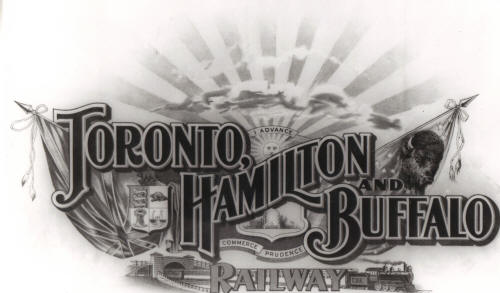The Toronto, Hamilton & Buffalo Railway was incorporated in 1884 to construct a
railway from Toronto, through Hamilton, to the International Bridge across the
Niagara River and into Buffalo, New York.
In 1890, the charter was amended allowing the eastern end of the line to
terminate at Welland, Ontario, and connect with the Canada Southern Railway.
In 1892, the TH&B commenced operations through the acquisition of the Brantford,
Waterloo and Lake Erie Railway. The
BW&LE operated a line between Brantford and a connection with the Canada
Southern Railway at Waterford and was in the process of extending the line
eastward from Brantford towards Hamilton.
The BW&LE depleted their capital funds during the extension to Hamilton
resulting in the sale of the line.
The TH&B completed the extension of the line into Hamilton along with
construction of the line between Hamilton and Welland in 1895.
The line between Waterford and Hamilton became the Waterford Subdivision
and the line between Hamilton and Welland became the Welland Subdivision.
During 1895, the railway was sold to a consortium that included the New York
Central, the Canada Southern, the Michigan Central and the Canadian Pacific
Railway. Ownership of the line was
distributed in the proportion 37.16% NYC, 13.89% CASO, 21.81% MCRR and 27.14%
CPR. The Canada Southern and
Michigan Central were subsidiaries of the New York Central so the actual
ownership of the TH&B was 73% NYC and 27% CPR.
The next phase of construction was to be the line from Hamilton to Toronto.
The surveyed route to Toronto closely paralleled the existing Grand Trunk
Railway mainline. In order to avoid
construction of a parallel line (and the potential loss of traffic to the
competing line), the GTR granted running rights to the Canadian Pacific Railway
between Toronto and Hamilton in 1896.
That same year the TH&B constructed what became known as the Hamilton
Connection between its line and the GTR at Hamilton Junction.
The Hamilton Connection was subsequently leased to the CPR and became
their physical connection to the TH&B.
In 1897, the TH&B obtained running rights over the Hamilton & Dundas Railway for
the provision of freight service into the Town of Dundas.
The H&D Railway, a local interurban line, ceased operations in 1923 and
the TH&B acquired the former H&D right of way into Dundas to continue freight
operations. The line into Dundas
was known as the H&D Branch.
In order to tap into Hamiltonís expanding industrial sector, construction began
on the Hamilton Belt Line in 1900.
The Belt Line expanded with the construction of two additional branch lines in
1911 to allow access to all industrial sectors of the city, many of which were
previously serviced exclusively by the GTR.
Although the Belt Line was only six miles in length, it contained over 40
miles of yard and industrial sidings and would provide much financial sustenance
to the TH&B over the years.
In 1914, the 14-mile Dunnville Subdivision was constructed southward from
Smithville to the Town of Dunnville and extended five miles further to the
shores of Lake Erie at Port Maitland in 1916.
Access to Lake Erie allowed the creation of the TH&B Navigation Co. that
operated between Port Maitland and Ashtabula, Ohio, from 1916 until
discontinuance in 1932.
The TH&Bís final expansion occurred in 1927 when running rights were awarded
over the Canadian National Railways to gain access to the industrial City of
Port Colborne.
1935 saw the first abandonment of trackage when the Ridgeville Spur, a small
four-mile branch extending off the Welland Subdivision just outside of Welland,
was abandoned and the rails were removed in 1936.
The St.
Lawrence Seaway Authority completed the construction of the present-day Welland
Canal in 1972 resulting in the relocation of several rail lines in the area.
The Welland Subdivision was realigned between Fenwick and Welland where a
new yard was constructed and operated in conjunction with New York Centralís
corporate successor, Penn Central.
The new shared facility allowed the closure and removal of the original and
independent TH&B and Penn Central operations located within the city.
Welland Yard continues to operate today as a Canadian Pacificís
marshalling facility for the Niagara Region.
In 1976, the United States Government amalgamated six bankrupt railroads,
including the New York Centralís corporate successor, Penn Central, into a new
entity called Conrail. In an effort
to reduce debt, Conrail began shedding foreign investments including their
controlling interest in the TH&B.
In 1977, CP Rail acquired Conrailís 73% interest giving CP 100% control of the
railway.
In 1985, CP Rail and Canadian National jointly acquired the assets of Conrailís
Canada Division, the former Canada Southern Railway.
CP Rail acquired exclusive ownership of the eastern end of the line
between the TH&B connection at Welland and the international border crossings at
Niagara Falls and Fort Erie, Ontario.
While CP equipment was used to operate this portion of the line, known as
CP CASO, the TH&B provided the managerial and administrative functions on CP
Railís behalf.
The TH&B would continue to operate as a separate entity until 1987 when it was
amalgamated into the Eastern Region of the London Division of CP Rail.
CP Rail abandoned the H&D Branch in 1988 with the Waterford Subdivision
following in 1989. Also in that
year, CP discontinued operations into Port Colborne, opting not to renew the
running rights agreement over the CNR.
Today, the surviving portions of the TH&B, including the Hamilton Belt Line, the
former Welland Subdivision and a portion of the Dunnville Subdivision operate as
part of Canadian Pacificís Hamilton Subdivision in CPRís Southern Ontario
Service Area.
